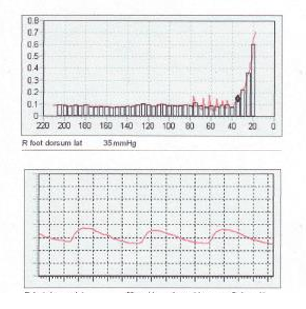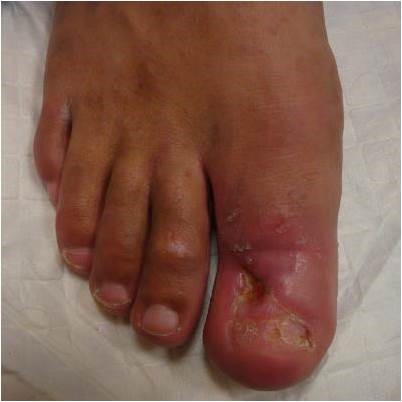Wounds are a symptom of disease, and usually the first disease we have to rule out in patients with lower extremity wounds is poor perfusion. Arterial disease is the most common reason, but not the only one. I rely on skin perfusion pressure (SPP) to determine whether the perfusion specifically to the area of the wound is adequate. I am going to post a series of articles explaining why I must have this machine or I can’t provide adequate care.
–Caroline
Because no one can heal without adequate perfusion…
This is a healthy looking, 30 y.o. man who’s had a non-healing left great toe wound for a year after he dropped something on his foot at work. He has smoked 2 packs a day for at least 10 years but has no known health problems. He’s employed as a machinist and has a new baby. For the past 12 months, he’s been treated at another wound center in my city and the toe has not gotten any better.
He’s only 30 years old, and the pattern of hair on his legs looks pretty normal. However, wounds are a symptom, so I need to know what this one is a symptom OF. We take the CMS approved arterial screening quality measure seriously. Quality Measures Provided by the US Wound & Podiatry Registries That means we perform an arterial assessment for healing potential on the FIRST VISIT on every patient with a non-healing lower extremity wound. His skin perfusion pressure (SPP) is 35 mmHg on the left, and his pulse volume recording (PVR) is flat. Any value in the 30’s is worrisome and the PVR suggests he has no pulsatile flow to that foot.

On careful questioning, he has claudication when he walks from one side of the machine shop to the other, and his father died of a heart attack at the age of 42. Angiograms confirmed severe arterial disease (thankfully his coronary arteries were clear). He required peripheral by-pass surgery. He also required treatment for osteomyelitis of the toe, since his wound had been open for a year.
What do we learn from this?
- Patients who don’t get better in other Houston area wound centers come to CHI St. Luke’s Wound Clinic eventually and we figure out what’s wrong with them, in part because we take arterial screening seriously.
- This patient wasted 12 months of care elsewhere because he didn’t get an arterial assessment.
- The Alliance of Wound Care Stakeholders and the US Wound Registry created a quality measure to assess patients for wound healing potential on their first visit.
- It took about 15 minutes with skin perfusion pressure.
I can’t be a wound care doctor without skin perfusion pressure, and apparently neither can anyone else.
–Caroline

Dr. Fife is a world renowned wound care physician dedicated to improving patient outcomes through quality driven care. Please visit my blog at CarolineFifeMD.com and my Youtube channel at https://www.youtube.com/c/carolinefifemd/videos
The opinions, comments, and content expressed or implied in my statements are solely my own and do not necessarily reflect the position or views of Intellicure or any of the boards on which I serve.



